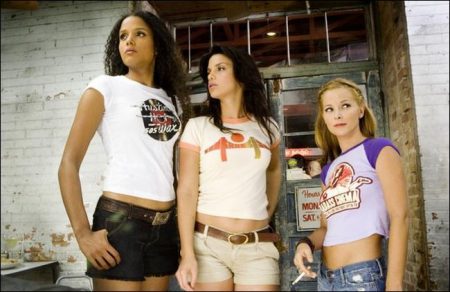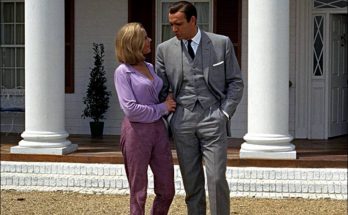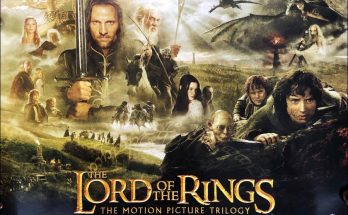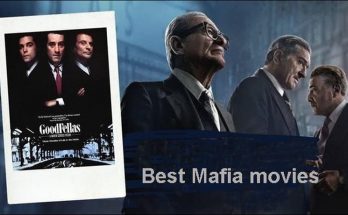Death Proof is the fifth film from Quentin Tarantino. Though Tarantino categorizes Death Proof as a slasher film, upon closer analysis, he amends the film’s genre classification: “It fuses the slasher film with high-octane car chase action, which was a big staple,”
Tarantino says. “They’re fused so much so that the genres switch hand at some point in the movie. I don’t even know exactly where that point is, but there is some point in the film when you’re watching the last twenty minutes, you’re not watching what came before. You have actually switched genres and you’re into a different movie. You’re involved with the characters so you don’t notice it, but you’re actually in a different movie.”
Though the concept seems unusual, those familiar with VANISHING POINT, DIRTY MARY CRAZY LARRY and GONE IN 60 SECONDS would notice a palpable shift from other 70s cinema prototypical slasher flicks like THE HOUSE AT THE EDGE OF THE PARK and BLACK CHRISTMAS. But to categorize the screenplay for DEATH PROOF as two distinct, genre-specific halves would be far too reductive. The film should also takes a cinematic leap by applying a period-specific film style (namely slasher and exploitation movies) and adding contemporary, independent, “badass” women in a genre in which scantily clad women were typically picked off one by one.
In fact, the “final girl,” a character archetype associated with slasher movies, has an unexpected finality long before the closing credits. Moreover, self-reflexivity takes an unprecedented jump with the introduction of Zoë Bell, the person, the character, the stuntperson and the actor. The role of Zoë was written specifically for Bell, who was Uma Thurman’s stunt double in KILL BILL. In DEATH PROOF, she’s karma personified and delivered to a film production in Tennessee. For all its differences, DEATH PROOF has motifs that are a trademark of Tarantino’s movie universe. There’s a familiar focus on people who work in the entertainment industry.
The characters spend much of their time discussing popular culture. There are color schemes that are obvious nods to KILL BILL. Products like Red Apple cigarettes and even Earl McGraw make a return appearance. But DEATH PROOF is also palpably different: the screenplay finds tension in leisure time, pleasure in examining the courtship process, and release in a blinding jolt of violence. It’s as much of a departure for the Oscar-winning writer / director / producer and now Director of Photography as any of his earlier films.
“It’s the little simple things that get me because it really makes the movie,” Rosario Dawson, who plays Abernathy, says.
Mary Elizabeth Winstead, who plays aspiring starlet Lee, was taken by the complexity of the film’s female characters and the richness and authenticity of the dialogue. “They’re likeable, but they’re flawed at the same time, and the dialogue is real. He didn’t try to write ‘girlie’ dialogue. This is the way girls really talk. They swear as much as guys do, they get as dirty just as much as guys do. I think he understood that, which is very cool.”
But the attention to everyday minutiae isn’t merely for entertainment, or to shed light on our cyborg evolution. DEATH is in the details. Tarantino’s absorbing, entertaining dialogue builds a connection between the audience and a stalker’s prey. Dawson references one of the film’s most interestingly filmed scenes to exemplify this distinction: “No one would shoot a bunch of people sitting around a table talking about a newspaper article,” she says. “The scene seems really small, but he introduces really key points into the story in such subtle ways. Somehow you get sucked in because you’re just following the characters, and you get to learn about people in these conversational scenes. It’s striking, and it’s beautiful, and it’s incredible to watch.”
Dawson breaks the film down to its elements and comes up with this enthusiastic endorsement: “It’s going to be the best car chases, it’s going to be the most bad ass chicks you’ve ever seen, it’s going to be the most sinister, scary kind of killer who’s sinister and scary in the way that you’ve ever seen before. And it’s going to be fun. It’s going to be something you’ve never seen Quentin do.”
“He takes the concept of grindhouse and then he subverts it with his very specific artistic preoperative,” Sydney Poitier, who plays Julia, comments. “He lifts it to this whole other level. It is a grindhouse movie but it’s also this other sort of indescribable, artistic expression. Quentin’s voice is Quentin’s voice, and it’s so influenced by the grindhouse era. We saw the movies that influenced him, and how they influenced what he created with this movie and with PULP FICTION and certainly with KILL BILL.”
Tracie Thoms, who plays Kim, adds: “It’s a slasher movie, a car movie, an action movie, and then a Quentin Tarantino movie, all at once. You have all the great dialogue that Quentin is brilliant at coming up with, and you have a crazy killer coming after you, and then you have a big car chase with dust and flips. There’s no CG. It’s just two cars going at it and ramming into each other repeatedly, and chasing each other. There’s a lot of action.”
Views: 137




